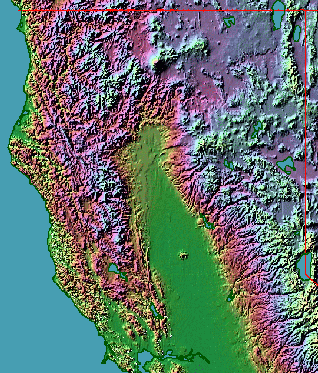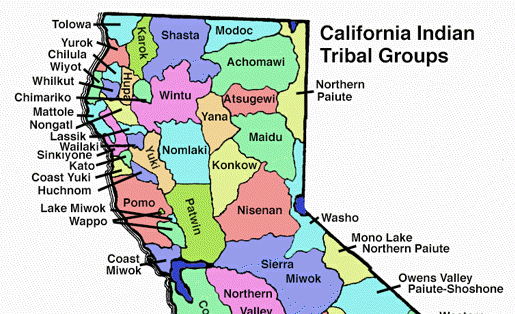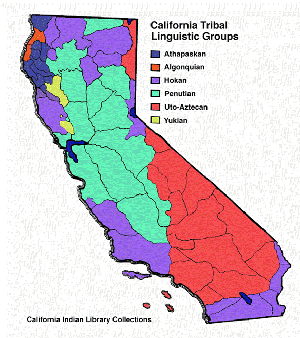Lassen Regional Project: Geographical and Ethnographic Overview
 The regions through which we will travel are quite diverse and include five of California's ten distinctive landforms. These are the Sierra Nevada, the Cascade Range, the Great Basin, the Central Valley, and the Klamath Mountains. We will visit six counties and touch seven traditional Native American habitats. As you can see in the map (Click on the map to see a larger version.), some of the topography is quite rugged.
The regions through which we will travel are quite diverse and include five of California's ten distinctive landforms. These are the Sierra Nevada, the Cascade Range, the Great Basin, the Central Valley, and the Klamath Mountains. We will visit six counties and touch seven traditional Native American habitats. As you can see in the map (Click on the map to see a larger version.), some of the topography is quite rugged.
The region is dominated by the northern end of the Great
Central Valley which is the Sacramento River Watershed. On the eastern side of the Valley, the Sierra Nevada Mountain Range has dwindled into a relatively low-altitude range; while the Cascade Mountain Range is just beginning to rise. In this unique region (north of Lassen itself), the Great Basin literally pours into the Sacramento Valley in the form of the Pit River Watershed. On the western side of the Valley, the Klamath Mountains show their most spectacular display in the Trinity Alps (northwest of Redding). Arching across the very northern part of the state, is the Klamath River, the first in a series of great rivers running west into the Pacific. And rising out of the southern Trinity Alps, the Trinity River flows west and, then, north to meet the Klamath.
The Sierra Nevada is a unique mountain range, running 400 miles north-and-south and consisting of an enormous east-west uplift in the earth's crust, approximately 50 miles wide. It is one of the largest single mountain ranges in the world. There are thirteen peaks along the Sierra over 14,000 feet and the floor of Owens Valley, east of the Sierra, averages 4,000 feet, making the eastern escarpment of the Sierra a dramatic 10,000 foot rise. The entire range, north-to-south, can be crossed only by traversing high passes. The Sierra forms an impenetrable western wall to the Great Basin, and it wrings out most of the moisture moving inland off of the Pacific. That water flows down the western slopes into the Great Central Valley and out to the Pacific through the Delta Region and San Francisco Bay.
In contrast, the Cascade Range is a collection of individual volcanic peaks running south-to-north from California through Washington. Landforms between these peaks are usually lower in altitude and frequently provide paths for drainage west to the Pacific. Thus, the western boundary of the Great Basin retreats inland to eastern Oregon and "tops out" in northeastern Oregon to allow for the great Snake River drainage. Mt. Shasta (14,62 ft) is the tallest Cascade Mountain in California, and Mt. Lassen (10,457 ft) is the second tallest. Sutter's Butte (the distinctive nob midway down the Sacramento Valley) may be the southern-most volcano of the Cascade Range.
The Klamath Mountains are actually the northern portion of the Sierra Nevada. This portion fractured and moved 60 miles to the northwest about 150 million years ago. This not only explains the topography which is much more rugged than the Coastal Mountain Ranges, to the south, but it also explains the discovery of gold in the Weaverville area, since the area is geologically similar to the western slope of the Sierra.
From the relief map, you can see that the Central Valley is very flat.
This is largely grass land, full of wildflowers in the spring. Oak trees
provided an abundance of acorns as a staple food supply, and grasses attracted
many game animals. The valley was cut by streams and rivers, especially from
the Sierra, and these offered indigenous people an abundance of fish, including ocean-going salmon. The Western Flyway passes down the Central Valley from north-to-south
so there was also a seasonal appearance of waterfowl.
Most of the remainder of the region is classic California foothill geography.
Oak forests become increasingly dense as the foothills are entered, but the
oaks give way to various pines and firs as elevation increases. While small
game animals become less frequent, larger game animals (deer and bear) replace
them. The forested slopes are no longer waterfowl habitat, but fish continue
to be a good food source along streams. Because of the direct drainage into
the Pacific, the Klamath and Trinity Watersheds had such exceptional fish
(salmon, stealhead, halibut, and eel) resources that a unique culture formed around
these staple foods. The Klamath Mountains receive very heavy precipitation and are closer to the Northwest in the character of forests and animal habitats. The northern Sierra Foothills are much drier.
The corridor surrounding the Pit River is unlike what we have described
and is closer to Great Basin geography. The portion that we will travel through is called the Modoc Plateau. It is a dry upland desert environment, 4,000 to 5,000 feet high. Annual precipitation is small here and comes mainly in the winter as snow. The cycle of vegetation begins in spring and most plants have gone to the seed phase by autumn and winter.
 A glance at the
Tribal Map for Northern California shows that traditional habitats conformed
to geographically distinct settings. The Achumawi and Atsugewi, for instance,
shared the lower-elevation drainage of the Pit River, with the Modoc to the upland north. (The Modoc lived in the region surrounding Lava Beds National Park.) The Yana, Maidu, Konkow, and
Nisenan Shared the gradual slopes of the western Sierra foothills, with Mt. Lassen being situated at the intersection of Yana, Atsugewi, and Maidu territories. Wintu
and Nomlaki shared the northern most end of the Sacramento Valley and southeastern
slopes of the Klamath Mountains. Shasta Indians made their traditional home
throughout the region surrounding Mt. Shasta and northwest toward the Klamath River drainage. The Trinity-Klamath drainage itself was shared by the Hupa, Karuk, and Yurok.
A glance at the
Tribal Map for Northern California shows that traditional habitats conformed
to geographically distinct settings. The Achumawi and Atsugewi, for instance,
shared the lower-elevation drainage of the Pit River, with the Modoc to the upland north. (The Modoc lived in the region surrounding Lava Beds National Park.) The Yana, Maidu, Konkow, and
Nisenan Shared the gradual slopes of the western Sierra foothills, with Mt. Lassen being situated at the intersection of Yana, Atsugewi, and Maidu territories. Wintu
and Nomlaki shared the northern most end of the Sacramento Valley and southeastern
slopes of the Klamath Mountains. Shasta Indians made their traditional home
throughout the region surrounding Mt. Shasta and northwest toward the Klamath River drainage. The Trinity-Klamath drainage itself was shared by the Hupa, Karuk, and Yurok.
To a high degree, these geographical
relationships determined strong cultural similarities. Indigenous
people were so highly tuned to animal and plant life available to them that
their material cultures were powerfully organized by the micro-niches in which they lived. People who shared geographically similar areas possessed strongly similar material cultures. Moving from one kind of geographical region into another, however, revealed strong differences in material life. Food and materials were so plentiful along the Klamath and Trinity Rivers that material abundance slipped over, as we will see, into social stability and complexity.
 The
California Language Map reveals some other interesting relationships. (Click
on the map to see a larger version.) The purple fields represent tribes speaking
Hokan languages. It is thought that the Hokan speakers were the original
inhabitants of the state, with considerable time depth (perhaps up to 8000
years). Dialect studies suggest that the Hokan speakers were interrupted
and separated from each other through the penetration of the Central Valley
by Penutian speaking peoples. Differences in dialects between separated Hokan
speakers indicate as much as 4,000 years of separation. Another interesting
situation developed about 2,000 years later, when Uto-Aztecan speakers spread
out of the Great Basin southwest into Southern California and all the way
to the Pacific.
The
California Language Map reveals some other interesting relationships. (Click
on the map to see a larger version.) The purple fields represent tribes speaking
Hokan languages. It is thought that the Hokan speakers were the original
inhabitants of the state, with considerable time depth (perhaps up to 8000
years). Dialect studies suggest that the Hokan speakers were interrupted
and separated from each other through the penetration of the Central Valley
by Penutian speaking peoples. Differences in dialects between separated Hokan
speakers indicate as much as 4,000 years of separation. Another interesting
situation developed about 2,000 years later, when Uto-Aztecan speakers spread
out of the Great Basin southwest into Southern California and all the way
to the Pacific.
While each of the regional sections following has an introduction to some aspects of the indigenous people related to that section, more detailed general information about California's Native people can be found in my online book, "The View from Native California".
 The regions through which we will travel are quite diverse and include five of California's ten distinctive landforms. These are the Sierra Nevada, the Cascade Range, the Great Basin, the Central Valley, and the Klamath Mountains. We will visit six counties and touch seven traditional Native American habitats. As you can see in the map (Click on the map to see a larger version.), some of the topography is quite rugged.
The regions through which we will travel are quite diverse and include five of California's ten distinctive landforms. These are the Sierra Nevada, the Cascade Range, the Great Basin, the Central Valley, and the Klamath Mountains. We will visit six counties and touch seven traditional Native American habitats. As you can see in the map (Click on the map to see a larger version.), some of the topography is quite rugged. A glance at the
Tribal Map for Northern California shows that traditional habitats conformed
to geographically distinct settings. The Achumawi and Atsugewi, for instance,
shared the lower-elevation drainage of the Pit River, with the Modoc to the upland north. (The Modoc lived in the region surrounding Lava Beds National Park.) The Yana, Maidu, Konkow, and
Nisenan Shared the gradual slopes of the western Sierra foothills, with Mt. Lassen being situated at the intersection of Yana, Atsugewi, and Maidu territories. Wintu
and Nomlaki shared the northern most end of the Sacramento Valley and southeastern
slopes of the Klamath Mountains. Shasta Indians made their traditional home
throughout the region surrounding Mt. Shasta and northwest toward the Klamath River drainage. The Trinity-Klamath drainage itself was shared by the Hupa, Karuk, and Yurok.
A glance at the
Tribal Map for Northern California shows that traditional habitats conformed
to geographically distinct settings. The Achumawi and Atsugewi, for instance,
shared the lower-elevation drainage of the Pit River, with the Modoc to the upland north. (The Modoc lived in the region surrounding Lava Beds National Park.) The Yana, Maidu, Konkow, and
Nisenan Shared the gradual slopes of the western Sierra foothills, with Mt. Lassen being situated at the intersection of Yana, Atsugewi, and Maidu territories. Wintu
and Nomlaki shared the northern most end of the Sacramento Valley and southeastern
slopes of the Klamath Mountains. Shasta Indians made their traditional home
throughout the region surrounding Mt. Shasta and northwest toward the Klamath River drainage. The Trinity-Klamath drainage itself was shared by the Hupa, Karuk, and Yurok.